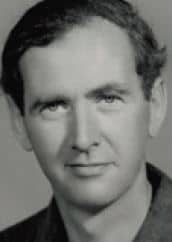Benjamin Leckie Strachan (known to all as Ben, or ‘Old Ben’) joined the 4th Hussars in Colchester in 1948, having served with distinction in the Royals in France, during which time he was mentioned in despatches, and later wounded and taken prisoner.

In 1948, he accompanied the Regiment to Malaya, where he was wounded in an ambush whilst commanding Recce Troop. After a recuperative tour at the D & M School, Bovington, he returned to Regimental Duty, this time with ‘D’ Squadron in Raub.
On the Regiment’s return to the UK, he transferred to ‘B’ Squadron in Warminster (whose envious position away from RHQ had earned them the nickname of ‘the Fifth Hussars’).
He then went on an Arabic language course in Beirut, which he completed with distinction, passing the Interpretership exam at First Class. This was followed by a tour in GHQ MELF in the Canal Zone, before rejoining the Regiment, this time in ‘B’ Squadron, in Hohne.
He enjoyed regimental soldiering and is fondly remembered by his contemporaries for his quiet efficiency, affable personality, keen sense of humour and infectious laugh. Stories abound concerning his somewhat unorthodox approach towards military dress.
Once, when required to parade for a Very Senior Visitor in Tidworth, he had to retrieve his Sam Browne from its useful position of holding down the bonnet of his car (a DIY estate version in which used X-ray plates from his father’s surgery served as a substitute for glass in the rear windows).
The Bhurtpore Barracks Officers’ Mess floor polisher was then set to work in an attempt to shine up the leather to a satisfactory standard – alas with spectacularly disastrous consequences.
However, the damage was repaired, and Ben went on parade more or less passably dressed.
On another occasion, a greatcoat parade, he sewed strips of yellow duster to the edges of his OR’s greatcoat to simulate the piping on the very expensive cavalry pattern greatcoats of his brother officers.
A story he used to tell against himself involved a Cavalry Memorial Parade. Arriving late after the Parade had moved off, he joined the Regimental contingent only to discover, to his alarm, that he did not recognise any of the other officers with whom he was marching.
To his relief, all was later revealed when he discovered that, in his haste, he had unwittingly joined the ranks of a more junior cavalry regiment whose blue and gold striped ties fairly closely resembled those of the 4th Hussars.
He was on the Technical Staff Course at the Royal Military College of Science, Shrivenham when the 4th and 8th Hussars amalgamated and never returned, now transferring to command a squadron in the 10th Hussars in BAOR.
It was during a later tour in Technical Intelligence (Army) in the War Office that he applied to join the Foreign Office and was accepted, retiring from the Army in 1961.
In the Foreign Office, he pursued a distinguished diplomatic career, serving as Ambassador in the Yemen, Lebanon and Algeria.
During the latter, he became heavily involved in the search for Mark (later Sir Mark) Thatcher, son of the Prime Minister, whose car had broken down in a motor rally in the desert.
He was appointed CMG in 1978 and retired in 1984, only to be recalled in 1990 to become Special Adviser (Middle East) during the First Gulf War.
After he left the Army, he continued to maintain contact with the Regiment both through his younger brother, Gordon, who was a National Service officer in Hohne and through his membership of the 4th Hussars Officers’ Dining Club, although after moving to his farm in Scotland, his attendance in London, sadly, ceased.
He married, firstly, Ellen, and secondly Lize. Altogether he had five children and 10 grandchildren.
He died on 12 July 2016, aged 92.


